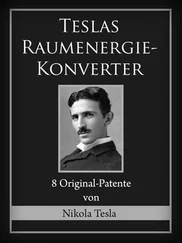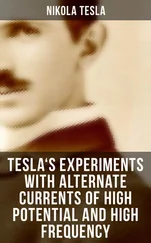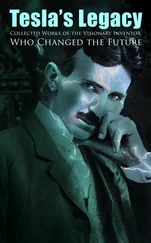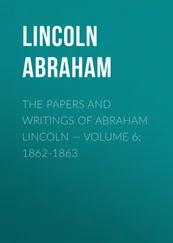 Fig. 2.
Fig. 2.
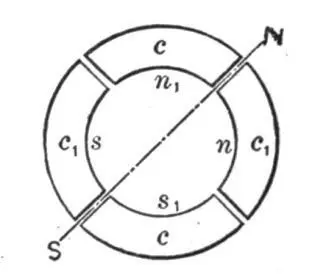 Fig. 2a.
Fig. 2a.
In Fig. 2, the armature coils are shown in a more advanced position, one-eighth of one revolution being completed. Fig. 2 a illustrates the corresponding magnetic condition of the ring. At this moment the coil C 1generates a current of the same direction as previously, but weaker, producing the poles n 1 s 1upon the ring; the coil C also generates a current of the same direction, and the connections may be such that the coils c c produce the poles n s , as shown in Fig. 2 a . The resulting polarity is indicated by the letters N S, and it will be observed that the poles of the ring have been shifted one-eighth of the periphery of the same.
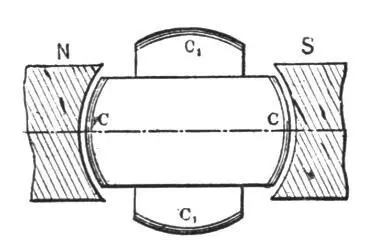 Fig. 3.
Fig. 3.
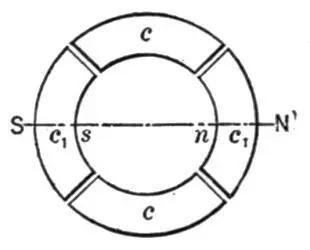 Fig. 3a.
Fig. 3a.
In Fig. 3 the armature has completed one quarter of one revolution. In this phase the current in coil C is a maximum, and of such direction as to produce the poles N S in Fig. 3 a , whereas the current in coil C 1is nil, this coil being at its neutral position. The poles N S in Fig. 3 a are thus shifted one quarter of the circumference of the ring.
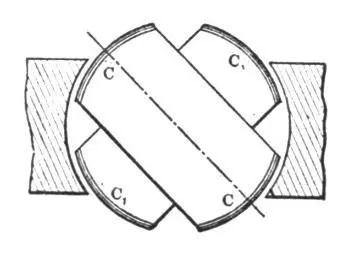 Fig. 4.
Fig. 4.
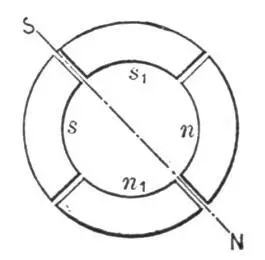 Fig. 4a.
Fig. 4a.
Fig. 4 shows the coils C C in a still more advanced position, the armature having completed three-eighths of one revolution. At that moment the coil C still generates a current of the same direction as before, but of less strength, producing the comparatively weaker poles n s in Fig. 4 a . The current in the coil C 1is of the same strength, but opposite direction. Its effect is, therefore, to produce upon the ring the poles n 1 s 1, as indicated, and a polarity, N S, results, the poles now being shifted three-eighths of the periphery of the ring.
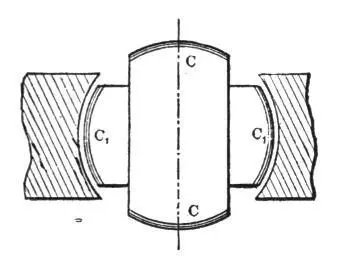 Fig. 5.
Fig. 5.
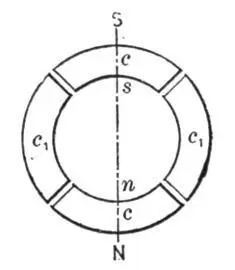 Fig. 5a.
Fig. 5a.
In Fig. 5 one half of one revolution of the armature is completed, and the resulting magnetic condition of the ring is indicated in Fig. 5 a . Now the current in coil C is nil, while the coil C 1yields its maximum current, which is of the same direction as previously; the magnetizing effect is, therefore, due to the coils, c 1 c 1alone, and, referring to Fig. 5 a , it will be observed that the poles N S are shifted one half of the circumference of the ring. During the next half revolution the operations are repeated, as represented in the Figs. 6 to 8 a .
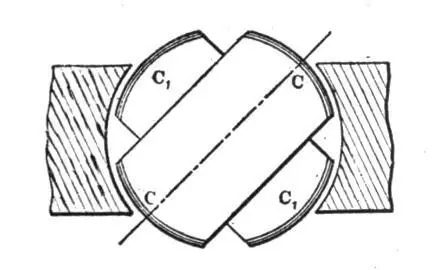 Fig. 6.
Fig. 6.
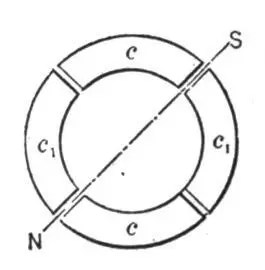 Fig. 6a.
Fig. 6a.
A reference to the diagrams will make it clear that during one revolution of the armature the poles of the ring are shifted once around its periphery, and, each revolution producing like effects, a rapid whirling of the poles in harmony with the rotation of the armature is the result. If the connections of either one of the circuits in the ring are reversed, the shifting of the poles is made to progress in the opposite direction, but the operation is identically the same. Instead of using four wires, with like result, three wires may be used, one forming a common return for both circuits.
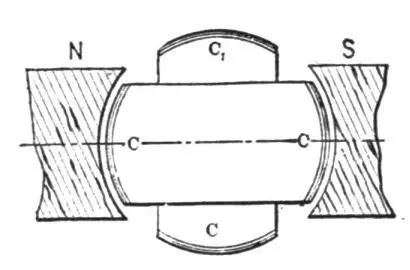 Fig. 7.
Fig. 7.
 Fig. 7a.
Fig. 7a.
This rotation or whirling of the poles manifests itself in a series of curious phenomena. If a delicately pivoted disc of steel or other magnetic metal is approached to the ring it is set in rapid rotation, the direction of rotation varying with the position of the disc. For instance, noting the direction outside of the ring it will be found that inside the ring it turns in an opposite direction, while it is unaffected if placed in a position symmetrical to the ring. This is easily explained. Each time that a pole approaches, it induces an opposite pole in the nearest point on the disc, and an attraction is produced upon that point; owing to this, as the pole is shifted further away from the disc a tangential pull is exerted upon the same, and the action being constantly repeated, a more or less rapid rotation of the disc is the result. As the pull is exerted mainly upon that part which is nearest to the ring, the rotation outside and inside, or right and left, respectively, is in opposite directions, Fig. 9. When placed symmetrically to the ring, the pull on the opposite sides of the disc being equal, no rotation results. The action is based on the magnetic inertia of iron; for this reason a disc of hard steel is much more affected than a disc of soft iron, the latter being capable of very rapid variations of magnetism. Such a disc has proved to be a very useful instrument in all these investigations, as it has enabled me to detect any irregularity in the action. A curious effect is also produced upon iron filings. By placing some upon a paper and holding them externally quite close to the ring, they are set in a vibrating motion, remaining in the same place, although the paper may be moved back and forth; but in lifting the paper to a certain height which seems to be dependent on the intensity of the poles and the speed of rotation, they are thrown away in a direction always opposite to the supposed movement of the poles. If a paper with filings is put flat upon the ring and the current turned on suddenly, the existence of a magnetic whirl may easily be observed.
To demonstrate the complete analogy between the ring and a revolving magnet, a strongly energized electro-magnet was rotated by mechanical power, and phenomena identical in every particular to those mentioned above were observed.
Obviously, the rotation of the poles produces corresponding inductive effects and may be utilized to generate currents in a closed conductor placed within the influence of the poles. For this purpose it is convenient to wind a ring with two sets of superimposed coils forming respectively the primary and secondary circuits, as shown in Fig. 10. In order to secure the most economical results the magnetic circuit should be completely closed, and with this object in view the construction may be modified at will.
Читать дальше
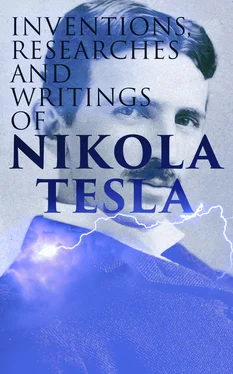
 Fig. 2.
Fig. 2. Fig. 2a.
Fig. 2a. Fig. 3.
Fig. 3. Fig. 3a.
Fig. 3a. Fig. 4.
Fig. 4. Fig. 4a.
Fig. 4a. Fig. 5.
Fig. 5. Fig. 5a.
Fig. 5a. Fig. 6.
Fig. 6. Fig. 6a.
Fig. 6a. Fig. 7.
Fig. 7. Fig. 7a.
Fig. 7a.